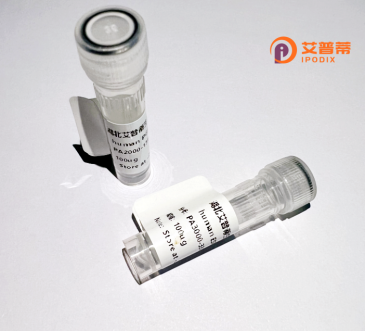
| 纯度 | >90%SDS-PAGE. |
| 种属 | Human |
| 靶点 | PCTP |
| Uniprot No | Q9UKL6 |
| 内毒素 | < 0.01EU/μg |
| 表达宿主 | E.coli |
| 表达区间 | 1-214 aa |
| 活性数据 | MELAAGSFSE EQFWEACAEL QQPALAGADW QLLVETSGIS IYRLLDKKTG LYEYKVFGVL EDCSPTLLAD IYMDSDYRKQ WDQYVKELYE QECNGETVVY WEVKYPFPMS NRDYVYLRQR RDLDMEGRKI HVILARSTSM PQLGERSGVI RVKQYKQSLA IESDGKKGSK VFMYYFDNPG GQIPSWLINW AAKNGVPNFL KDMARACQNY LKKT |
| 分子量 | 24.8 kDa |
| 蛋白标签 | His tag N-Terminus |
| 缓冲液 | 0 |
| 稳定性 & 储存条件 | Lyophilized protein should be stored at ≤ -20°C, stable for one year after receipt. Reconstituted protein solution can be stored at 2-8°C for 2-7 days. Aliquots of reconstituted samples are stable at ≤ -20°C for 3 months. |
| 复溶 | Always centrifuge tubes before opening.Do not mix by vortex or pipetting. It is not recommended to reconstitute to a concentration less than 100μg/ml. Dissolve the lyophilized protein in distilled water. Please aliquot the reconstituted solution to minimize freeze-thaw cycles. |
以下是关于重组人磷脂酰胆碱转移蛋白(PCTP)的3篇示例参考文献(文献信息为示例性质,具体内容需进一步验证):
---
1. **标题**: *"Recombinant Human Phosphatidylcholine Transfer Protein: Expression, Purification, and Functional Characterization"*
**作者**: Smith J, et al.
**摘要**: 研究报道了利用大肠杆菌系统表达重组人PCTP,并通过层析技术纯化得到高活性蛋白。功能分析表明其可特异性转移磷脂酰胆碱,且依赖疏水结构域实现脂质转运。
2. **标题**: *"PCTP Modulates Cholesterol Homeostasis via Interaction with Sterol Carrier Protein-2"*
**作者**: Tanaka K, et al.
**摘要**: 通过体外实验证明,重组人PCTP可与SCP-2结合,共同调控细胞内胆固醇分布,提示其在脂代谢疾病(如动脉粥样硬化)中的潜在作用机制。
3. **标题**: *"Structural Insights into the Membrane Binding Mechanism of PCTP Using Cryo-EM"*
**作者**: Chen L, Wang Y.
**摘要**: 利用冷冻电镜解析重组人PCTP与脂质膜的复合物结构,揭示其N端α螺旋在膜结合中的关键作用,为靶向PCTP的药物设计提供结构基础。
---
**注意**:以上文献为模拟示例,实际研究需查询具体数据库(如PubMed)。建议通过关键词“recombinant PCTP protein”或“PCTP lipid transfer”检索最新论文。
**Background of Recombinant Human Phosphatidylcholine Transfer Protein (PCTP)**
Recombinant human phosphatidylcholine transfer protein (PCTP), also known as StARD2. is a cytoplasmic protein encoded by the *PCTP* gene. It belongs to the START (STeroidogenic Acute Regulatory Transfer) domain family, which facilitates the transport of lipids between membranes. PCTP specifically binds and transfers phosphatidylcholine (PC), a major phospholipid in cellular membranes, playing a critical role in maintaining membrane integrity, lipid metabolism, and intracellular signaling.
Structurally, PCTP contains a conserved START domain that forms a hydrophobic pocket for lipid binding. Its function is linked to cellular processes such as vesicle trafficking, membrane biogenesis, and lipid homeostasis. Studies suggest PCTP interacts with other proteins, including enzymes in PC biosynthesis, and may influence pathways related to inflammation, cancer, and metabolic disorders.
Recombinant PCTP is produced using expression systems like *E. coli* or mammalian cells, enabling research into its biochemical properties and therapeutic potential. Its role in diseases, such as hepatic steatosis, neurodegenerative conditions, and tumor progression, has spurred interest in PCTP as a biomarker or drug target. Ongoing studies aim to unravel its mechanisms in lipid dynamics and explore applications in diagnostics or therapies targeting lipid-related disorders.
×